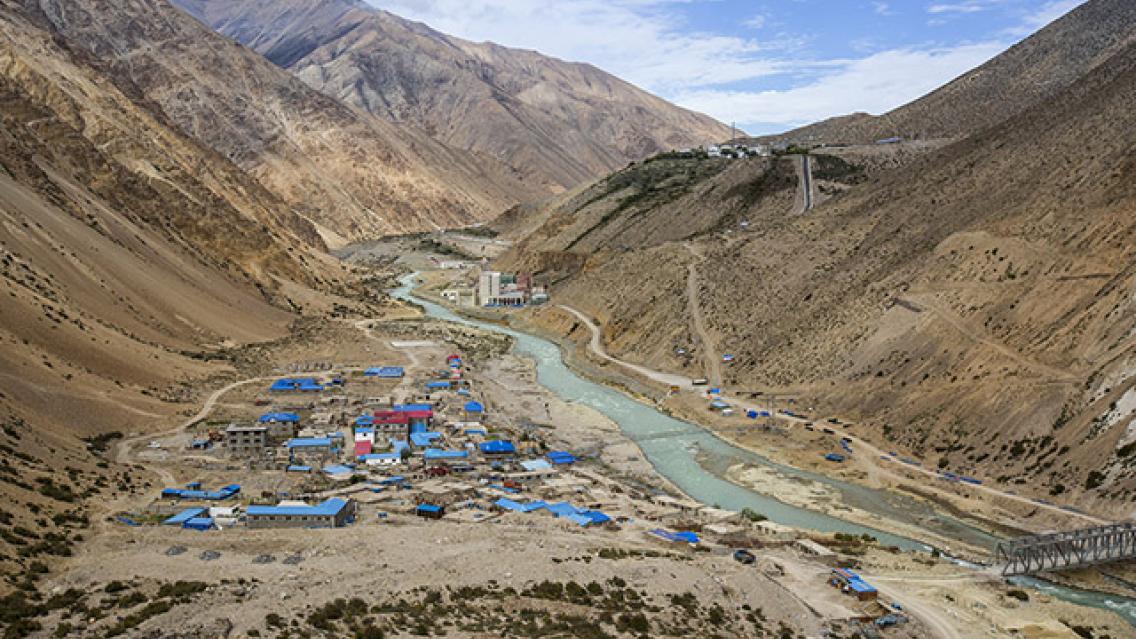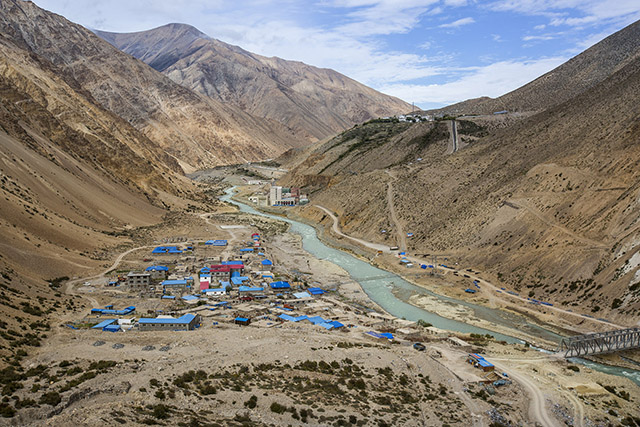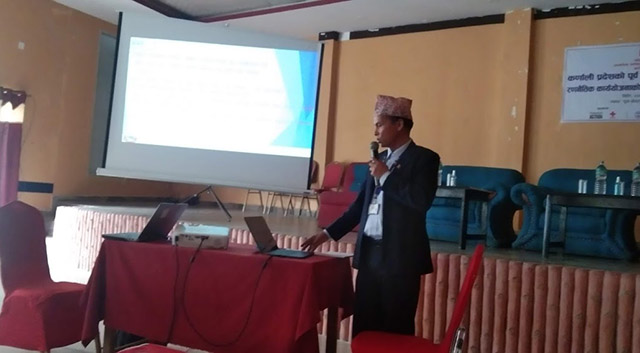Covering all bases: Nepal's Karnali Province plans for multi-hazard early warning systems

Every monsoon, the meandering Karnali River swells, erodes rivers banks, and carries away arable soil as it hurtles downstream. And every year, for all its nourishing powers, the Karnali can spell doom for riverine communities. In 2014, floods and landslides on the river caused the loss of 222 lives and affected 120,000 others, leaving damaged infrastructure and property in its wake. Last year, monsoon floods and landslides claimed 14 lives, and 16 went missing in the two provinces that share the Karnali River.

The Karnali River at the Nepal-China border in Hilsa, Nepal. From its headwaters in the Tibetan Plateau, the
Karnali carves its path through Nepal before joining the Ghaghara River further downstream in India.
Photo credit: Jitendra Raj Bajracharya/ICIMOD
The Karnali Province, named after the river, annually faces an array of hydro-meteorological and other disasters – floods, droughts, landslides, lightning, and fires. These recurrent hazards need to be monitored and managed, and response courses have to be mapped to minimize the risk of potential disasters. In light of this urgent need, ICIMOD has been working with Practical Action, the Ministry of Internal Affairs and Law (MIAL), and Nepal Red Cross Society to support the provincial government of Karnali in preparing a strategic action plan to establish, run, and manage a multi-hazard early warning system (EWS) for the different river basins in the province. By integrating learnings on EWSs and forecast-based preparedness into the provincial Disaster Risk Reduction and Management (DRRM) Policy, the strategic action plan will contribute to saving human lives, reducing human suffering, and preventing economic and environmental loss from recurring disasters in the province.
Varied disasters, tailored needs
On 19 March 2021, Practical Action, MIAL, ICIMOD, and Nepal Red Cross Society organized a consultative workshop to discuss the strategic action plan on EWSs for the Karnali Province at its provincial capital in Birendranagar, Surkhet. The workshop brought together representatives from provincial government agencies, Nepal Red Cross Society, UN agencies, Nepal Police, Nepal Army, international nongovernment organizations and nongovernment organizations, and local media agencies.
Secretary Punya Bikram Poudel, MIAL, chaired the day-long programme. Birendra Bahadur KC, MIAL’s Deputy Secretary, presented the ministry’s progress and plans on EWSs and disaster management in the province. Keshab Sharma, the Department of Hydrology and Meteorology’s (DHM) former Director General, presented key findings of previous consultations on the plan, and Dharam Uprety, Thematic Lead – Climate and Resilience, Practical Action, presented the overall approach of EWSs and why they are important for building resilience.

Secretary Punya Bikram Poudel, MIAL, chaired the day-long program. Photo credit: Practical Action
The strategic action plan will build on information collected through multiple consultative workshops and field visits to river corridors and interactions with at-risk communities in Kalikot, Jumla, Jajarkot, and Surkhet districts. A 10-member advisory committee headed by the Under Secretary, MIAL, comprising the DRR focal person at MIAL; officers from relevant provincial ministries (Ministry of Industry, Forest and Environment, Ministry of Social Development, Ministry of Land Management, Agriculture and Cooperatives, Ministry of Economic Affairs and Planning, and Karnali Province Planning Commission); and representatives from Nepal Red Cross Society, Practical Action, and ICIMOD guided the development of the strategic action plan.
Participants advised that the plan should address the need of the most vulnerable people, including watermill owners and users who fall victim to monsoon-induced disasters – floods and landslides – every year. They also raised concerns on the lack of tailored and localized risk messaging and emphasized the need to include contextual risk information in forecasts and to capacitate local-level institutions with human and technical resources.
Bhesh Bahadur Thapa, Nepal Red Cross Society’s Chair in Surkhet, shared that the DHM disseminates generic information on precipitation and floods. However, a large section of the vulnerable population is often unaware of the level of floods they may face. As a result, many lives were lost and a lot of infrastructure was damaged during the Surkhet floods in 2017. With similar floods a likelihood in the future, the provincial authorities are seeking a comprehensive EWS that provides tailored risk messaging and adequate lead time to at-risk communities. Secretary Poudel underlined the importance of rolling out such an action plan in a region prone to multi-hazards. He added that the suggestions received from various stakeholders will be instrumental in guiding development of the plan. The secretary also called for wider support for the rollout and committed to allocating resources from the provincial government.
Enhancing flood early warning systems in the HKH region
ICIMOD, under its SERVIR-HKH Initiative, is collaborating with Brigham Young University, NASA’s Jet Propulsion Laboratory, and national partners to enhance flood early warning systems in Bangladesh and Nepal. By downscaling global flood discharge forecasts with routing models, the Streamflow prediction Tool – Nepal provides 10-day streamflow forecasts for major rivers in Nepal. Similarly, the HIWAT Streamflow Prediction Tool – Nepal provides 48-hour forecasts for river streams in Nepal.
SERVIR-HKH supported the organization of the consultation workshop and the development of the strategic action plan. In Nepal, SERVIR partnered with the DHM and Practical Action Nepal to further calibrate and validate the results from the tools and also engage different stakeholders including local governments and at-risk communities, with the end goal to educate/engage communities in making use of Earth observation data in early warning systems.
Written by Dharam Uprety, Thematic Lead – Climate and Resilience at Practical Action, and Utsav Maden of SERVIR-HKH/ICIMOD. This article was originally featured on SERVIR-HKH's website. Click here to go to the original post.

